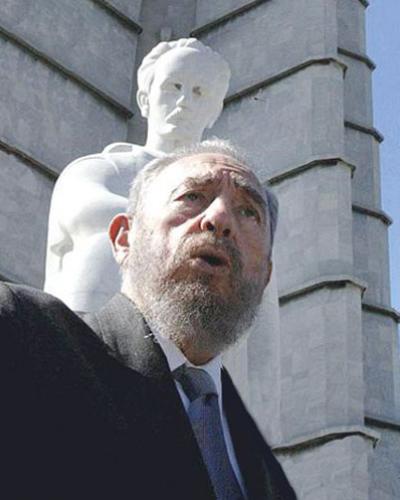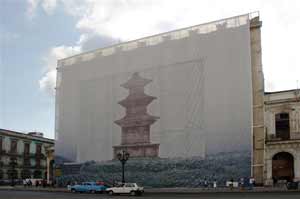First of all, it is significant that the Comandante en Jefe made time and devoted energy to a meeting of this kind. Only a few months had passed since the mercenary invasion at Playa Girón on the Bay of Pigs, and while the victory was fresh in everyone’s mind, the drums of war had not ceased. On the contrary, Washington had redoubled its efforts to engender counterrevolutionary bands around the country; the cruel effects of the blockade were being felt in the daily life of the population; and South Florida was being established as the nesting ground of subversion for the U.S. dependent bourgeoisie which had been defeated in Cuba.
Regardless, the country’s political leadership considered the dialogue necessary, one that could not be delayed. Culture was a priority – and as we will see, continued to be, and is today. Between 1959 and 1961, amidst profound, radical socio-economic transformations, and the sharpening of conflict between the U.S. and Cuba, founded were the Cuban Institute of Cinematographic Art and Industry, the Casa de las Américas, the national printing facility, and re-founded were the National Ballet, under the direction of Alicia Alonso, and the National Symphony Orchestra. The National Theater began to take shape, and just hours before the aggression at Girón began, the training of arts instructors for primary and secondary schools was launched.
The most transcendental cultural project underway at that time was the Literacy Campaign, with more than 268,000 volunteers, in every corner of the country. Some 707,000 people learned to read and write, in less than a year.
There have been many malicious distortions of the letter and spirit of a single, oft-quoted phrase in Fidel’s speech: “Within the Revolution, everything; against the Revolution, nothing.” Sometimes “against” is replaced with “outside” or the statement’s broad, inclusive foundation is confused with an intention to restrict, diametrically opposed to this very precise political formulation. The idea was, and is, synonymous with unity within diversity, construction of a consensus, beyond current or possible differences, a broad variety of points of view, beyond sects and dogmas. “Against” was and is the inalienable right of the Revolution to exist and defend itself, then and now, against aggression, threats, and dangers.
Fidel expressed a basic principle, “Allow me to tell you that, in the first place, the Revolution defends liberty, that the Revolution has brought the country a great number of liberties, that the Revolution cannot, by its very nature, be an enemy of liberties; if someone’s concern is that the Revolution may suffocate the creative spirit, this concern is unnecessary, this concern is unjustified.”
He stated later, “It is possible that men and women, who in reality have a truly revolutionary attitude, may not constitute a majority of the population revolutionaries are the vanguard of the population. But revolutionaries must aspire to having the entire people march forward with them.
“The Revolution cannot forego that all honest men and women, be they writers or artists, march forward with it; the Revolution must aspire that everyone who has doubts becomes a revolutionary; the Revolution must attempt to win over the greatest portion of the population with its ideas; the Revolution must never renounce counting on the majority of the people, counting not only on revolutionaries, but on all honest citizens, although they may not be revolutionaries – that is to say, that although they may not have a revolutionary attitude about life – they are with the Revolution.”
A re-reading of ‘Words to Intellectuals’ leads us to consider a broad range of issues and proposals, whose relevance, in the majority of cases, should guide our current efforts.
Of special significance among these is the prospect of creating and supporting a system of cultural institutions to encourage creative work, and promote it on a broad scale socially. The democratization of culture has been one of the pillars of the Revolution’s efforts in this arena of life.
Fidel’s dream of “creating the conditions which allow all artistic, literary or scientific talent, of any kind, to be developed,” has been coming true. A
year after these words, came the creation of the National Art Schools, of Cubanacán – the cornerstone of an arts education program later extended throughout the country – providing children and youth, who because of their origins could not even dream of academic training, access to this type of training and skills in a wide range of artistic expressions. This process has continued, reaching unprecedented levels, with highly qualified musicians, dancers, visual artists, actors, and performers graduating every year.
Those meetings, in June of 1961, established an ongoing, fluid channel of communication between the country’s political leadership and its artistic and intellectual movement.
Writer Ambrosio Fornet has lucidly commented, “What he (Fidel) said was that we all belonged to a single movement that we called the Cuban Revolution, a movement of transformation. And the question he asked intellectuals and artists was: How are you going to participate in this process? What can you contribute to this process? He left a response to both of these, and at the same time, one for practical activity, for real functioning, not in accordance with preferences, but in order to insert the cultural debate within the process of change.”
Fidel was the one who unequivocally asserted, “The Revolution means precisely more culture and more art,” reaffirming the commitment of the country’s political vanguard to this essential dimension of development.
He, who then proclaimed, “We are going to make war on ignorance, we are going to wage a battle against ignorance, we are going to ignite an irreconcilable argument against ignorance,” was the same person who years later, in the 1990s, amidst the hardship and tenacious resistance of those difficult times, said “Culture is the first thing that must be saved.”



